Ashton-under-Lyne
Ashton-under-Lyne Town Centre
Services in Ashton-Under-Lyne
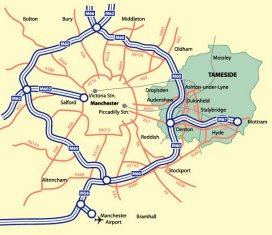 The Council Offices are located at
The Council Offices are located atTameside Metropolitan Borough Council
Tameside One
PO BOX 317,
Ashton-under-Lyne,
OL6 0GS
General Call Centre phone number - 0161 342 8355
Ashton Market
Ashton Market
Take a look at our market opening time, locations, and other general information
History of Ashton-under-Lyne
Early History
There has been considerable dispute about the origins of the town's name. Ashton is fairly clear - village of or surrounded by ash trees. It is 'under-Lyne' that is contentious. It possibly refers to the boundary line between Lancashire and Cheshire. However the forest of Lyme once covered this area, so the derivation could be from either, or both. In fact the town's full name was not widely used until the mid 19th century to distinguish it from other Ashtons.Ashton was a very small market town from medieval times until late in the 18th century. The centre lay around the Parish Church of St. Michael's, which was probably mentioned in the Doomsday Book. In the adjacent square stood the Market Cross, but the rest of the town consisted of little more than 'four narrow dark streets' being Crickets Lane, Scotland Street, Albion Street and part of Old Street. Ashton Parish, however, covered a large area having four divisions, Town,
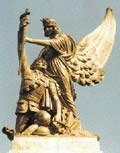 Audenshaw, Knott Lane and Hartshead, which included Mossley and part of Stalybridge.
Audenshaw, Knott Lane and Hartshead, which included Mossley and part of Stalybridge.Ashton became a Parliamentary Borough in 1832 - the first local town to do so. By 1847 it had become a Municipal Borough with an elected Council - the Town Hall dates from this time. Strangely, the new Borough did not officially apply for a Coat of Arms until 1926 when one was granted.
Industrialisation
Ashton's growth in the period 1770-1850 was phenomenal. Its population increased by 300 per cent between 1770-1800 reaching 8,000, and then rocketing to 36,000 by 1851. This was the result of the Industrial Revolution, for Ashton developed as an important centre of the cotton industry which employed most of her new inhabitants. Ashton's other major industry was coal mining. The town lies on the South Lancashire Coalfield. In the early 19th century there were numerous collieries around the town, Lordsfield and Heys being examples. Local coal was particularly useful as coal-fired steam engines replaced water power in the mills.Ashton became exceptionally well served by communications. By 1811 it was the centre for three canals and by the 1860s had four railway stations. A virtually new town grew up to the west of the old centre - the wide intersecting streets of Old Street, Stamford Street, Cavendish Street and Warrington Street being developed by the Lord of the Manor, the Earl of Stamford. Housing and sanitary conditions, if very poor until late in the 19th century, were often better than in most factory towns. Indeed, the Communist leader Friedrich Engels said of Ashton in 1844 'it has a more satisfactory appearance than that of most factory towns'.
Gradually industry developed in the villages that surrounded Ashton at Hurst, where the Whittaker family built a considerable cotton business; at Park Bridge, where Lees' iron works flourished by supplying textile machinery; and later at Ryecroft and Waterloo, where large mills were built.
Social Unrest
Ashton was prominent in successive movements in the 19th century which aimed at improving work and living conditions. Ashtonians were at Peterloo, and the town developed a reputation for violent strikes, notably in 1842 when, along with Stalybridge, the town's workers were the first to 'turn out' in what became a nationwide strike. The town was a stronghold of the Chartist movement which sought the vote for all adult males - out of a population of less than 23,000, only 650 had the vote. In 1848 a policeman was killed in Bentinck Street at a time when local Chartists thought a national revolution was likely. The town boasted the presence of two of the leaders of the factory reform movement, the MP Charles Hindley, and the Methodist minister Joseph Rayner Stephens, himself a Chartist sympathiser.Hugh Mason
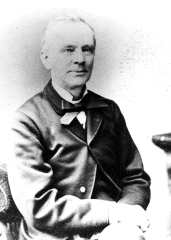 The Mason family came to the area in 1776 from Derbyshire, settling in Stalybridge. Thomas Mason had become a mill owner of some importance by the time his third son, Hugh, was born in 1817. At the age of 10, Hugh was working in the mill but he then went to school before working as a bank clerk. At 21 he joined the family business. From the first he became the dominant force, showing the same energy that would make him 'the most powerful man in the business, social, religious and political life of Ashton'.
The Mason family came to the area in 1776 from Derbyshire, settling in Stalybridge. Thomas Mason had become a mill owner of some importance by the time his third son, Hugh, was born in 1817. At the age of 10, Hugh was working in the mill but he then went to school before working as a bank clerk. At 21 he joined the family business. From the first he became the dominant force, showing the same energy that would make him 'the most powerful man in the business, social, religious and political life of Ashton'.By 1853 the Mason family had built the two Oxford mills at Ryecroft, excellently appointed and which, 10 years later, were run by Hugh alone, his father and brothers having retired. Mason built up what he saw as a model, industrial community around his factories, with comfortable housing and recreation facilities for his workers. These included a sports ground, children's playground, swimming and washing baths, and on Ann Street, an Institute which housed a library, smoking and chess rooms, at a cost to Mason of £4,500. In 1871 he became the first local employer to give his workers Saturday afternoons off - a step which other employers often, reluctantly followed. Mason's workers certainly enjoyed better conditions than others in the town, but he expected them to follow his own strict moral codes; there were no public houses in Mason's community and all Ashton knew what was meant by an 'Oxford Education'.
Mason was a passionate Liberal and a Nonconformist in religion, worshipping at the Congregationalist Albion Chapel along with many other powerful Ashtonians. He was mayor from 1857-1860 but, despite being the most prominent local Liberal, he resisted attempts to nominate him as a parliamentary candidate until 1880 when he was elected MP for Ashton. Mason was a stern man with little time for those who opposed his views, particularly Tories and Anglicans, his arch-enemy being the local Tory leader Isaac Watt-Boulton. Ashton political life was particularly bitter in these years with Mason bearing the brunt of the Tory attack. Mason died in 1886. Even on his death bed he was in dispute with the Tories over his election defeat.
Ashton saw great improvements between the years of Mason's mayoralty and his death. In 1861 the Infirmary was opened; in 1862 the new Albion School; in 1870 the Public Baths; and in 1873 Stamford Park. The Library, then in the Town Hall, opened in 1882. Improvements were also made in housing conditions and, in almost all cases, Mason's influence and the example offered by his own community were to the fore.

The Twentieth Century
In the early 20th century Ashton developed most of the other facilities that shape modern life. In 1902 the first electric trams ran in the town and the sewage works opened. The next 30 years saw the first council housing estates and the building of many new schools, notably Stamford and the Grammar School. By 1925 even outlying districts like Waterloo were served by electricity. Three years later the area's most famous landmark - Hartshead Pike - was restored.This period, however, witnessed the collapse of the cotton industry and the town was forced to develop a variety of light industries to take the place of cotton as the town's main employer. Many mills were converted from cotton to other uses; for example Whittakers Mill which became 'Cake-a-Pie' Confectionery.
The most tragic event in Aston's history occurred in 1917 when a munitions factory in the West End blew up killing 47 and injuring 350 - an event known around the town for years as 'the great explosion'. The town lost hundreds of men in both World Wars and was bombed in 1940.
In the post-war era Ashton has seen a great deal of re-building and modernisation in the town centre. The terrible slums of Charlestown have gone - the last evidence of the living conditions of most nineteenth century Ashtonians. In 1991, the town's population was just over 44,000.
Coat of Arms
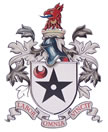 Argent, a mullet sable, pierced of the field; in dexter chief a crescent gules. Crest: On a wreath of the colours, Upon the battlements of a tower proper, a griffin's head erased gules, charged on the neck with a crescent Or. Motto: Labor omnia vincit. Granted 7 July 1926.
Argent, a mullet sable, pierced of the field; in dexter chief a crescent gules. Crest: On a wreath of the colours, Upon the battlements of a tower proper, a griffin's head erased gules, charged on the neck with a crescent Or. Motto: Labor omnia vincit. Granted 7 July 1926.The silver shield with the black five-pointed star was the arms of the Assheton family from the early Middle Ages, and branches of the family used the arms with slight differences or by adding the marks of younger sons. One such mark is the crescent, and it was this particular branch of the family whose arms were assumed by the Town Commissioners in the 1830s. The Borough Council inherited this assumption in 1847 but it was not until 1926 that The College of Arms granted the present arms which denote the borough while retaining the link with the original lords of the manor. The motto means Persistent Works Triumphs and is a quotation from Virgil's Georgics.
Facts About Ashton-under-Lyne
A comprehensive selection of historical photographs can be found at www.tameside.gov.uk/history- In 1906, Ashton Library saw the introduction of open access. Ashton was a pioneer of open access - previously readers had to choose books from a catalogue and could not browse among the shelves. The entire stock had to be re-catalogued and classified as it did not need to be in subject grounds under the closed access system. This meant that Ashton became one of the first libraries in this country to adopt the Dewey Decimal Classification - still used in most public libraries today!
- Henry Neild Bickerton, the pioneer of the gas engine, established the National Gas Engine Company Ltd at the Wellington Works in Ashton in 1889. These works produced two-cycle gas engines which were widely used in electric power plants, cotton mills and other works. In 1907 the National Gas Engine Company LTD became part of Mirrlees, Bickerton and Day, which Henry set up to produce diesel engines. By the time of Bickerton's death in 1929, the company was one of the largest producers of gas engines and oil engines in the world!
- Ashton's electricity supply began in 1899, originally to power tram cars and later street lights. Ashton Moss Colliery was one of the first businesses to be supplied, but by 1925, a showroom was opened in Stamford Street where domestic appliances could be inspected and bought or hired!
- Tea retailer and wholesaler and founder of the firm of Brooke, Bond and Co, tea importers, Arthur Brooke was born in George Street Ashton. His father was a tea merchant, but Arthur's first employment was in a local mill. When that closed down Arthur took up a post with a tea merchants in Liverpool, but returned to join his father in his Ashton business, with responsibility for tea sales throughout Lancashire. He opened his first shop in 1869, selling packaged tea retail, a new concept at that time, under the brand name Brook, Bond and Co - however, there was no Mr Bond. The firm became a limited company in 1892 and thereafter concentrated on the wholesale business.
- The custom of riding the Black Lad or Black Knight was unique in Ashton. History records that the Black Knight was actually a man called Sir Ralph de Assheton, a friend of King Richard III. An event called The Riding of the Black Lad was staged as long ago as 1795. By the twentieth century this had transformed into something resembling a carnival. It then became known as the Black Knight Pageant and a Pageant Queen was crowned by the Mayor and Mayoress each year!
The Pageant was resurrected during 1999 thanks to the Tameside Lions Club, Sir Ralph will once again climb into the saddle on Saturday 3rd July 1999.
- The Cordingley family have been surveyors and land agents since the early 19th century and administer the still extensive residue of the Earl of Stamford's estate!
- Churches and Chapels played an important part in the life of Ashton, as with all the Tameside towns. The Annual Whit Walks is still a very prominent event all over the Borough!
- The population of Ashton was recorded at 44,385 during the 1991 census - making it the most populated of the 9 towns in the Borough of Tameside.
- Labour MP Margaret Beckett was born in Ashton
- Ashton received a Royal Charter to hold a market in 1413 though some authorities believe an earlier charter was granted in 1284.
The blue plaque can be located at the Market Hall in Ashton
- Nicknamed the 'Cigarette VC' for reasons which will become clear, Forshaw is honoured in the Museum of the Manchesters in Ashton Town Hall. His Victoria Cross is on display and one of the galleries is named after him.
The blue plaque can be located at the entrance to Ladysmith Barracks
- The Green Plaque at The Broadoak Hotel in Ashton-under-Lyne, marks the site where the first 'Gardeners Question Time' was broadcast. On that first panel was Bill Sowerbutts.
- The blue plaque located at the Territorial Army Centre on Old Street, Ashton-under-Lyne, previously the Drill Hall of the 9th Battalion Manchester Regiment, was unveiled on 30th October 2000 as a tribute to RQMS Harry Grantham, MBE DCM.
- Sited at the Central Library, Old Street, Ashton-under-Lyne this plaque commemorates the life of Raymond Ray Jones, a highly talented artist born in Ashton-under-Lyne.
- Sited on the gate of the former barracks on Mossley Road, Ashton this plaque commemorates the army barracks which stood on this site from 1845 and were the headquarters of the Manchester Regiment from 1881 to 1958.
- The plaque paying tribute to Hannah Mitchell is on 43 Elizabeth Street, Ashton under Lyne where she lived from 1900 - 1910.
- This plaque above Kenworthy's Jewellers, 226 Stamford Street, Ashton commemorates local poet Francis Thompson.
- A plaque on Ashton Town Hall pays tribute to those eight men associated with Tameside who have been awarded the Victoria Cross.
- The Blue Plaque situated on the bridge at Donkey Stone Wharf recognises Eli Whalley, whose firm was founded in the 1890's and was the last in the country to mass produce donkey stones.
- Erected on the Odd Whim Public House, Mossley Road, Ashton under Lyne, this plaque remembers Prophet John Wroe who founded the Christian Israelite Church.
- Geoff Hurst, the only person ever to score a hat-trick in a World Cup final lived in Denton once, although he was born at Tameside Hospital’s forerunner, the old Lake Hospital, Ashton, in 1941.
- Simone Perrotta who played for Italy in the 2006 World Cup final was born in Ashton on 17 September 1977
Places of Interest in Ashton-under-Lyne
Museum of the Manchesters
Based in Ashton Town Hall, the Museum embraces the long and colourful history of the 63rd and 96th Regiments of Foot, formed in the 18th Century, who became the Manchester Regiment in 1881. It then follows the Regiment's history during its 200 years of service until amalgamation with the King's Regiment (Liverpool) in 1958 to form today's King's Regiment, which has the honour and privilege of the Freedom of the Metropolitan Borough of Tameside.Portland Basin Museum
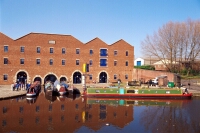 In the attractive, waterside setting of Portland Basin, the newly refurbished Heritage Centre celebrates the people, events and industries which have shaped the history of Tameside over the past 200 years. Exciting displays, interactive computers, hands-on exhibits, a period street scene, and working models combine to provide an informative and enjoyable day out, while at the same time telling the fascinating story of how people lived and worked in the past, and of the area's major industries and manufacturers. Other displays tell of Tameside's political history; of the Chartist Movement and of major social reformers such as Joseph Rayner Stephens, Ada Summers and Hannah Mitchell.
In the attractive, waterside setting of Portland Basin, the newly refurbished Heritage Centre celebrates the people, events and industries which have shaped the history of Tameside over the past 200 years. Exciting displays, interactive computers, hands-on exhibits, a period street scene, and working models combine to provide an informative and enjoyable day out, while at the same time telling the fascinating story of how people lived and worked in the past, and of the area's major industries and manufacturers. Other displays tell of Tameside's political history; of the Chartist Movement and of major social reformers such as Joseph Rayner Stephens, Ada Summers and Hannah Mitchell.Hartshead Pike
This was the third tower to be built in the area. The first tower was rebuilt in 1758, but developed a huge crack which led to its collapse in 1820. The present building was put up to commemorate the marriage of the Prince of Wales (later Edward VII) in 1863. It was paid for by public subscriptions. The Tower stands at nearly 300 metres above sea level and is famous for its views of four counties. The Pike at one time probably served as a beacon hill to warn of the approach of the Spanish Armada.Ashton Parish Church (St Michaels and All Angels)
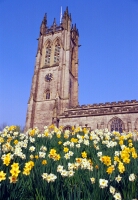 This magnificent church is mentioned in the Doomsday Book. The 15th century stained glass is unrivalled in the region and it is a Grade 1 Listed building. The tower gives excellent views of the area. Parish registers dating back to 1594 enable people to trace their family trees.
This magnificent church is mentioned in the Doomsday Book. The 15th century stained glass is unrivalled in the region and it is a Grade 1 Listed building. The tower gives excellent views of the area. Parish registers dating back to 1594 enable people to trace their family trees.Listed Buildings in Ashton-under-Lyne
Listed Buildings in Ashton-under-Lyne
Take a look at the listed buildings around Ashton-under-Lyne.

